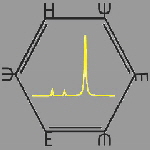Home
Astrochemistry is one of the fascinating, quiet young and fast-growing branch of science with a plenty of key and fundamental unsolved mysteries As our understandings and discoveries of outer space complex phenomenon are growing rapidly, all different basic sciences are necessarily recalled for solving every problem in this field. This naturally puts the stage of astrochemistry as a multidisciplinary science.One particular discipline which has opened its way almost instantly to astrochemistry applications, from its very early beginnings, was computational quantum chemistry (CQC). These applications cover a broad range, from resolving the astronomical recorded spectra at different wavelength ranges to shed the light into the kinetics and thermodynamics of chemical reactions underlying the formation of exotic interstellar species and a compass to search for vital molecules like amino acids through out the infinity of space.Although the CQC techniques are widely used in chemistry, physics, biology and related subjects, they are all new and have been developed during the last 50 years. Their credibility to solve a particular problem is tightly bound to the computer science, which itself is a fast growing field of study in both academia and industry. Their challenges, failures, and successes in giving the deep insight in molecular level into the phenomena occurred in well-known laboratory conditions have been well documented. For instance, the challenge of reaching to the chemical accuracy of 1 kcal/mol in calculated molecular heat of formation at certain temperature and pressure. Nowadays CQC is an inseparable part of astrochemistry and it is of high priority that this science and its tools are developed to tackle the problems in this field with an acceptable level of accuracy. It should be emphasized that because of the complex nature of astronomical phenomena, CQC is currently not only applied to solve a problem but also deliver the correct understanding about the problem.
To our surprise, the signatures of unknown big organic molecules (estimated to be nano size) have been discovered in the interstellar media by space telescopes. At present, it is a changeable theoretical task to apply correlated models such as coupled-cluster, perturbation theory or even density functional theory (DFT), directly to calculate spectroscopic properties of big molecules with more than 300 atoms. The usual practice is to add more mathematical approximations in order to make the calculations feasible. At the end, the results are not accurate enough to be useful in astrochemistry
For instance, the accuracy of most accurate DFT functionals, evaluated by reproducing the experimental infrared bands of moderate size molecules, reaches to 34 cm-1 after applying different empirical corrections. However the desirable accuracy is to reach below 15 cm-1 (equivalent to 0.1 microns) for large size molecules which is crucial in resolving the astronomical IR features. This needs the mathematical framework and computer codes of correlated models to be revisited, modified and if necessary to be developed from the scratch.
Yet there are modern theories and practices such as quantum theory of atoms in molecules (QTAIM) which they still have not fully opened their ways to the field of astrochemistry. In some extends QTAIM has been used to uncover the structure and bonding of exotic interstellar species but its real strength has not been applied further for this matter
 |
|